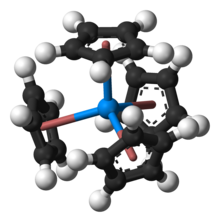Tetrakis(cyclopentadienyl)uranium(IV)
Tetrakis(cyclopentadienyl)uranium(IV), U(C5H5)4, abbreviated U(Cp)4, is an organouranium compound composed of a uranium atom sandwiched between four cyclopentadienide rings.
Tetrakis(cyclopentadienyl)uranium(IV) was first prepared in 1962 by Ernst Otto Fischer, who reacted uranium tetrachloride with excess potassium cyclopentadienide in benzene and obtained the complex as red crystals at 6% yield:[1][2] Solid crystals of U(Cp)4 are air-stable, but the benzene solution is extremely air-sensitive.
Reduction of U(Cp)4 with uranium metal yields tris(cyclopentadienyl)uranium(III), U(Cp)3.
[1] MgCpBr (TiCp2Cl)2 TiCpCl3 TiCp2S5 TiCp2(CO)2 TiCp2Me2 VCpCh VCp2Cl2 VCp(CO)4 (CrCp(CO)3)2 Fe(η5-C5H4Li)2 ((C5H5)Fe(C5H4))2 (C5H4-C5H4)2Fe2 FeCp2PF6 FeCp(CO)2I CoCp(CO)2 NiCpNO ZrCp2ClH MoCp2Cl2 (MoCp(CO)3)2 RuCp(PPh3)2Cl RuCp(MeCN)3PF6
